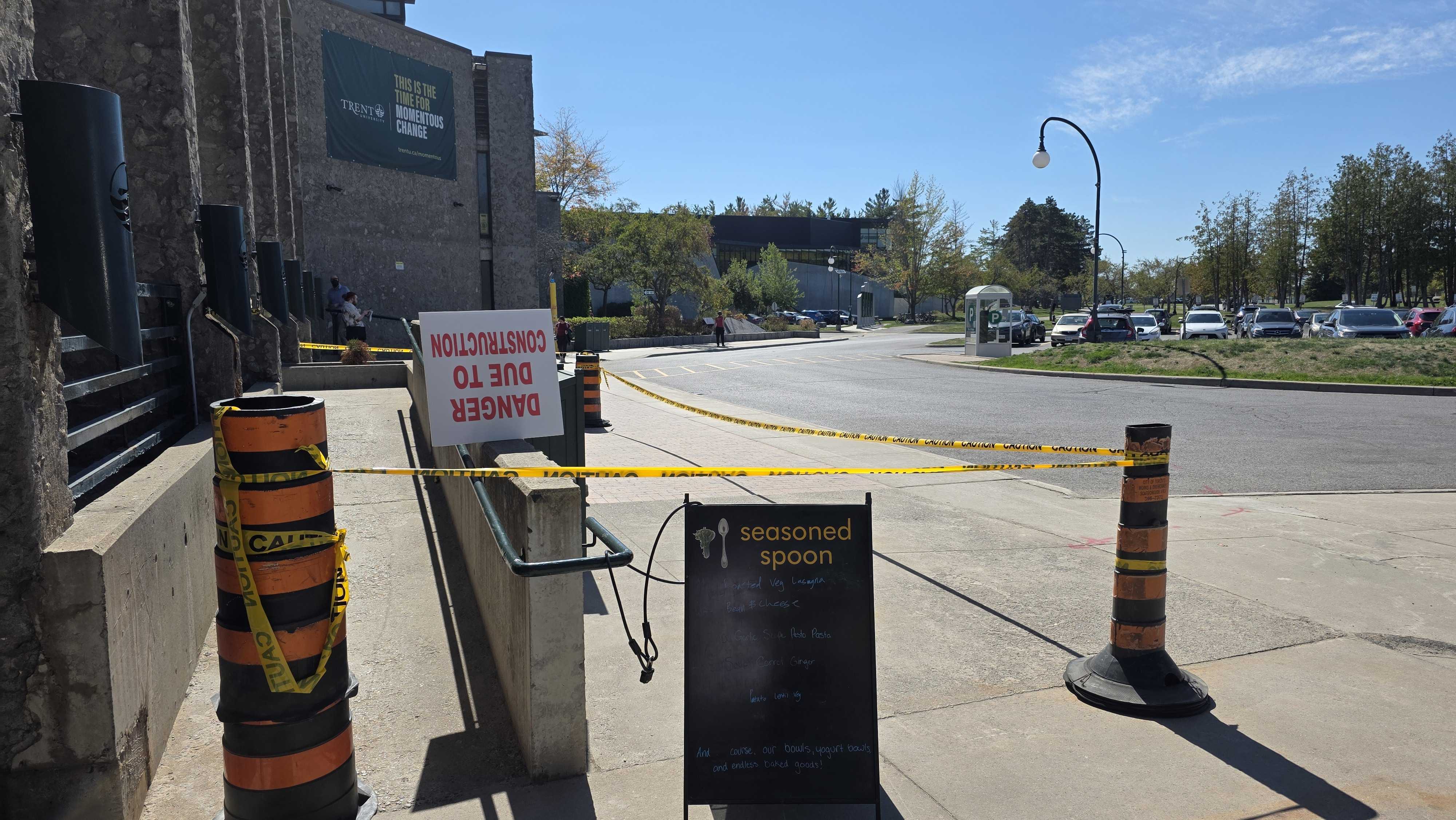All spaces in this article are (somewhat) visible in this picture. Can you spot them all?
As the weather gets colder and we begin to spend more time indoors, the buildings on campus provide a warm and welcome refuge for students. Many choose to spend their time inside the library, sitting at study booths overlooking the icy river. Others go to the common spaces of Lady Eaton, Champlain, or Otonabee College to relax and catch up on some readings.
A significant number of students, however, find themselves on the East Bank, in the big yellow and black building known as Gzowski College.
Though they may pass through it daily, many students are unaware of the distinctions between the areas which contain Enweying, Gzowski College, First Peoples House of Learning, The Gathering Space, and Nozhem Theatre. In order to help students locate and make use of these great spaces, we thought it would be helpful to provide an overview and short background of each.
Enweying
Enweying translates from Nishnaabewin to mean “the way we speak together,” and is the correct name of the six-storey, multi-coloured building that dominates the eastern campus landscape. Enweying hosts both Peter Gzowski College and the First Peoples House of Learning.
The name Enweying was chosen to honour former CBC broadcaster and Trent Chancellor, Peter Gzowski, who believed strongly in “creating a dialogue among the various parts of Canada in the hopes that we would understand ourselves better and learn how to live well with each other.”
Traditional Aboriginal teachings emphasize achieving peace through dialogue and learning to live in harmony with one another. These ideas are evident in the construction of the building, which is a shared home for the departments of Indigenous Studies, Economics and Mathematics, the Business Administration program, and the Office of Research and Graduate Studies, as well as approximately 250 residence students.
In addition to the iconic yellow outside walls, the other three colours of the medicine wheel (red, black, and white) are also present, following a vision statement submitted by the First Peoples House about honouring the land and creating a respectful community. This makes Enweying the only colourful building on campus, and is a thoughtful addition to the Trent landscape.
Gzowski College
Gzowski (pronounced Zaaa-ski) may be the youngest college at Trent, but with nearly 800 students passing through the Enweying building daily, it sure makes a big statement on campus! Named after the legendary Canadian journalist and broadcaster, Peter Gzowksi, this college is home to students who are encouraged to “pursue their passions in the same way their college namesake followed his passion for Canada, its culture, the north, Aboriginal people, and the environment.”
Themes that guide this college include developing a strong community, collaborative partnerships, and promoting environmental initiatives, such as those relating to sustainability, fair trade, and honouring Indigenous ways of knowing. The college motto is: “Nendimowinan e-niigaanbidegin zhidchigaadenoon nongwa” meaning “The minds of the future are made great beginning today.”
First Peoples House of Learning
At the heart of the First Peoples House of Learning (FPHL) is a desire to support academic programming and student success. The FPHL is located in the Enweying building on the east side of the Symons Campus.
Rather than being grouped in one singular location, FPHL is a combination of several areas spatially distributed throughout the building which includes Nozhem, The Gathering Space, First Peoples lecture hall, the Administrative Centre for the department of Indigenous Studies, Elder and Student Centre, and the traditional outdoor teaching areas of the tipi and sweat lodge.
The goal of these spaces is to introduce Indigenous “cultural knowledge and thought into the university in a respectful way. Aboriginal people and others are brought together in a spirit of co-operative learning. The unique spaces encourage thoughtful reflection, inquiry and complex understanding.”
The Gathering Space
The Gathering Space, more formally known as the Ernie and Florence Benedict Place, is located in Room 103 of the First Peoples House of Learning.
This spacious area is open to Trent students of all disciplines and is equipped with several couches and tables, providing an excellent spot to relax or quietly meet with study groups.
The Gathering Space features large, beautiful windows which overlook the river and field area, and is architecturally distinctive on campus. The building is clad in weathered steel which was chosen to honour the legacy of the Mohawk/Iroquoian steelworkers in this territory.
Inside, a medicine wheel adorns the floor while photographs and original art pieces add presence to the walls.
The Gathering Space also hosts many of the First Peoples House of Learning activities and events, including traditional teachings and creative workshops, almost all of which are open to students.
Nozhem Theatre
Indigenous performance and Cultural Studies students will surely be familiar with Nozhem Theatre, but others might not be.
Nozhem Theatre, also called the First Peoples Performance Space, is located on the bottom floor of Gzowski College at the end of the long passageway on the right side of the building.
The theatre has seating for one hundred people, and is unique in that, unlike traditional Western style performance spaces, this theatre is intended to be used “for ceremony, as a vessel to pour forth and nurture Aboriginal oral tradition, language, and knowledge.”
The relatively small size of the venue means that audience members are invited to develop an up-close and personal relationship with the many artists, singers, dancers, and performers, making Nozhem a rare gem on campus.


.png)


.jpg)


.jpeg)



.jpg)

.jpg)









.png)